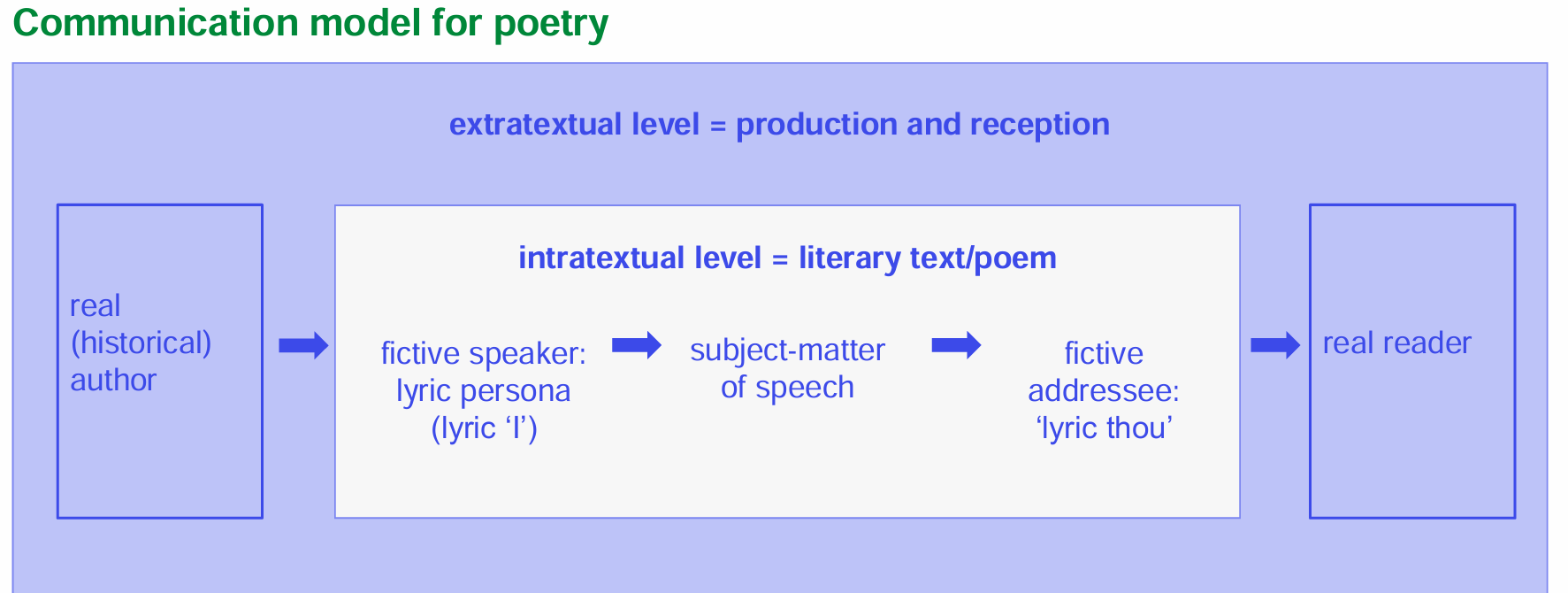2 Poetry 1
1/23
There's no tags or description
Looks like no tags are added yet.
Name | Mastery | Learn | Test | Matching | Spaced |
|---|
No study sessions yet.
24 Terms
Typical characteristics of poetry:
Verse form (as opposed to prose)
Defamiliarisation (остранение, ostranenie)(poetry makes language feel fresh or strange)
Brevity & intensity
Stanzas instead of paragraphs
Often has a lyrical "I" (a subjective speaker)
Use of imagery, rhythm, sound repetition, and self-awareness of its own form
Communication Model for Poetry

Types and Traditions of poetry
Epic
A long, elevated narrative poem recounting the adventures of a hero (e.g. Homer’s Iliad).Lyric
A relatively short poem expressing the personal emotions or thoughts of a single speaker (the “lyric I”).Ballad
A narrative poem, originally meant to be sung, typically composed in quatrains with a simple rhyme and meter, often recounting folkloric or dramatic tales.Love Poetry
Poems—lyric or narrative—that focus on the experience, emotions, and imagery of romantic love.Elegy
A mournful, contemplative poem lamenting a death or serious loss, often moving from grief toward consolation.Pastoral
Poetry idealizing rural life and landscapes—shepherds, nature, simplicity—often as a contrast to urban complexity.Light Verse
Humorous or playful poetry that often employs strict form (rhyme, meter) to comic or satirical effect.
Narrative Poetry vs Expressive Poetry
Narrative poetry tells a story and involves a sequence of events unfolding over time. Examples include epic, ballad, romance, and loosely, blank verse.
Expressive poetry focuses more on emotion, thought, and reflection rather than time-bound storytelling. Examples include lyric, elegy, love poetry, and pastoral.
What does topos mean?
A topos (plural topoi) means "a place," but in literary terms it refers to a recurring theme or concept, like the idea of a hero being physically strong. It’s essentially a commonplace motif used across different works.
What is a motif?
A motif is a dominant or recurring element in a literary work that symbolizes or reinforces its central themes. Like the Green light in The Great Gatsby
Why can any one definition of epic never be satisfactory? What does Williams propose instead to note as remarkable about this form of poetry?
One definition cannot capture the epic's diversity across cultures and times. Instead, Williams highlights its grand ambition—the epic explores the fate of individuals within broader national or cosmic histories, mixing human and superhuman, past and present. It's a tradition that is constantly rewritten and shaped by political or social ambitions.
How can the lyric be differentiated from the epic and dramatic?
The lyric is usually spoken by a single voice, expressing personal thoughts or emotions, often in the first person. It doesn’t involve the exchange of voices (as in drama) or grand-scale storytelling (as in epic). It captures intense, often momentary feelings, sometimes with musical qualities.
How can the ballad’s main features be explained historically?
Ballads originated in oral cultures to transmit stories, values, and news through song. Their repetitive structure, simple language, and memorable rhythm made them ideal for collective singing and cultural transmission, often associated with minstrels or traveling performers.
Is the genre of Romance to be understood in terms of our modern use of ‘romance’ and ‘romantic’?
No. The Romance genre originated in medieval verse tales of knights and supernatural challenges, not modern love stories. While love can be a theme, the focus is more on chivalric adventure, supernatural trials, and moral tests.
What functions does elegiac poetry fulfill?
Elegies mourn the dead, memorialize their lives, and offer public or private consolation. They bridge private grief and public expression, and often idealize the deceased while reflecting on the emotional impact of loss and the possibility of moving forward.
What paradoxes arise from the thematic focus, typical motives, and style of pastorals?
Pastorals idealize rural life, yet are often written in highly stylized, Classical language by urban elites. They depict idyllic leisure while praising laborers, but only when they’re not working. This tension creates room for ironic reflection or even political commentary on authenticity and urban corruption.
What does Williams mean when referring to the “cultural work” (p.57) of poems?
“Cultural work” refers to how poems, especially those using conventions like the pastoral, reflect and shape societal values, ideologies, and tensions. Poems may appear simple or nostalgic, but they often engage in sophisticated commentary on contemporary issues.
Describe the relationship of light verse with form.
Light verse is heavily reliant on form—rhyme, rhythm, and structure are key. Though it may seem effortless or humorous, it often follows strict formal patterns, such as limericks or villanelles. This precision supports its playfulness and accessibility, and allows it to subtly critique more “serious” poetry.
Some Rhetorical figures
Device | Definition | Example |
|---|---|---|
Alliteration | Repetition of the same initial consonant sound in two or more neighboring words. | “Sweet scent of sage” |
Onomatopoeia | A word whose sound imitates or suggests its meaning. | “The bees buzzed, and the brook gurgled.” |
Metaphor | A direct comparison between two unlike things, stating one is the other. | “Time is a thief.” |
Simile | A comparison between two unlike things using “like” or “as.” | “Her smile was like sunshine.” |
Metonymy | Substituting a related word or phrase for the thing meant. | “The pen is mightier than the sword.” (pen = writing; sword = force) |
Personification | Attributing human qualities or actions to non-human entities. | “The wind whispered through the trees.” |
Hyperbole | Deliberate exaggeration for emphasis or effect. | “I’ve told you a million times.” |
Irony | Saying one thing but meaning the opposite, or an outcome contrary to expectation. | “A fire station burns down.” |
A direct comparison between two unlike things
"time is a thief”